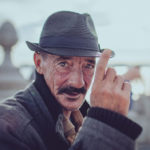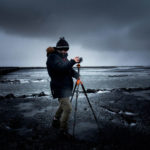1. Use a lens that has a wide aperture like f/1.2, 1.4, 1.8. The 50mm f/1.8 is only $100, and it is a terrific lens! My whole body of work is done with a 50mm f/1.8 and a Canon Rebel XS. So with that 1.6 crop factor it becomes an 80mm lens that is a perfect perspective to take portraits!
2. Photograph in the shaded areas with even light hitting your subjects face.

“Yana” captured by Aleksandra Chebotova (Click Image to See More From Aleksandra Chebotova)
3. Focus on the eyes. If your aperture is wide open you will need to keep the focus on the eyes. The rest of the face will be slightly out of focus. You need to be closer to your subject to get this effect.
4. If you want to photograph your subject from head to toe carefully choose your aperture setting to allow your subject to be totally in focus. If you are still shooting wide open at a f/2.8 for instance, your depth of field is too shallow to have your subject in full focus. Close down your aperture to about f/5.6, don’t take your shutter speed lower than 1/125 because it will cause blur. Increase your ISO to 200 and see if you can bring enough light in to get a great shot. This is assuming you are shooting in shade or at dusk or both. These settings are suggestions to get you to understand what I am saying, so play around with different combination’s to find out what works best.
5. Shoot in manual mode. I have read so many articles that say to rely on aperture priority mode, and that is OK for the first month as you get to know your camera. If you want quality photographs you really have to go for it and learn manual.
6. Be sure there is light reflecting in your subject’s eyes. You can achieve this even in the shade. Always turn your subject toward the light source to make this happen.
7. Give your subject something to hold, I often use flowers with children, even boys look adorable with flowers. I have used seashells when shooting at the beach.
8. Be aware of what is in your background. I try to have light and shade in my background and to keep it very simple, so the subject is the focus. I also find when shooting outdoors my favorite portraits end up being the ones that have an endless background, rather than a bush, or a wall.

“Helena Altgott” captured by Leo Rey
9. Have some input on how your subject will dress for the picture. I give a lot of input on wardrobe for family portraits and for my child photography. Remember you are the artist creating your vision, so clothing and props matter.
10. Buy Photoshop Elements and learn to install actions that help you edit your pictures. I use PSE 8 and I have bought Florabella actions and Child’s Play. Lucky for me these action creators have made their actions compatible with Photo Shop Elements, and some actions only work with the professional version of Photoshop. Editing and actions has taken my pictures to a new level. Since I shoot in the shade I rely on the actions to lighten and brighten my images and they do such a great job!
Author
Kathleen Pace – http://www.amelyajaynephotography.com
Like This Article?
Don't Miss The Next One!
Join over 100,000 photographers of all experience levels who receive our free photography tips and articles to stay current:






I got a 50 recently and can’t stop using it! It does almost everything I need it to, fantastic piece of gear.
Hi everyone!
I am awfully new to photography and just about to invest in the lumix G5, I have only owned point and shoots in the past. I need advice on which lens to buy with it, should I just get the one that comes with the kit or buy the body separately and a better lens, I do not want to have to upgrade anytime soon? Again I am clueless but eager to start this adventure :) Any advice will be appreciated.
Thanks!
Pamela
I’m just bought my 1st SLR T2i in Jan 2011 plus 5ea L lenses of all sorts. I enjoyed reading and found your column very useful. You gave some basics what to look in taking portrait pictures, and that was exactly what I was looking for.
Up to now I have been allowing the camera to make the choices. And to tell the truth I was amazed at the clarity of the pictures at full automatic. Even got some beautiful bokeh background shots of my wife so I felt all I needed was IS AF and a good L lens and let the camera do the work. You opened the box to experiment. Lovely pictures you posted.
What’s A/V? Sorry, meant AP (aperture priority)
My 2 cents:
I’ve done some professional portrait photography but I’m mostly an amateur.
Definitely give input on clothes. You want the primary point of interest of the picture to be on their face not their clothes! Solids and darker colors work for me but usually I tell them to wear solid colors that they look good in.
I only use manual mode when shooting with studio lights. Otherwise I don’t think it is worth the effort, personally. What are you using to judge whether the photo is right? If you are using the camera’s light meter then you might as well use A/V. Otherwise you are “chimping” and the camera’s LCD can deceive you. I shoot in A/V and tweak the exposure as I feel is needed. I let the camera do the calculations and focus on the subject’s expression, pose, etc…
I use a full frame camera and my favorite focal length is 85mm (50mm on a cropped camera). Just the right distance from the subject to engage them but not be in their face. For groups I use a 24-70mm which is just the flexibility needed, especially and mixing and matching people in the group.
For shutter speeds 1/60th is the lowest if they are standing still but 1/125 is the absolute lowest if they might be moving (kids, action shots, etc).
i personally found this very helpful. thank you. i started getting into photography about two years ago. i am now almost 18, and graduating from highschool. im opening my own business, and its helpful to read what you have said. i have my own website also: silverspurphotography.webs.com
thanks!
Katelyn Dame
RebelXS + 50mm 1.8.. WOW.. you must be kidding.. love the photographs on your photo stream!
Mark, it may be time to up the dosage on the medication.
These tips were meant for beginner photographers interested in taking better portraits. I guarantee you that any beginner that were to follow each and every one of these tips would be more than happy with the portrait results they achieve as a result. I looked through your website (http://markpashia.com) and not a single human portrait.
Mark: Why do you feel it necessary to act like a “know it all ” in a degrading way. The person who wrote this article is giving her advice, which is exactly that , hers. Everyone has different opinions. What you wrote might seem crazy to someone else who has more experience and knowledge than you. The high class professional photographers don’t act like you. You just are embarrassing yourself.
Unfortunately item number one is totally false. While an 80mm lens is a good focal length for portraits, it only has the “perspective” on a full frame camera. You are using a crop sensor which gives you an approximate 80mm focal length, but you still have a 50mm perspective which is a “normal” lens. You don’t get the advantages of a full frame camera’s perspective this way. The primary advantage of slightly telephoto lenses for portraits is the compression of the depth of the scene and for that you need to be over 50mm actual lens focal length without any conversion for “crop factor”. I also disagree about the 50mm f/1.8 being a “great lens” for portraits. There are much better lenses out there. The one you use has less blades on the shutter, so the bokah is less than desirable and the resolution is not as good as other lenses. The resolution problem will show up when you try to print in large sizes. The 50mm f/1.2 L lens is much better for these reasons. More blades on the shutter make for much smoother bokah and the additional resolution makes printing large easy to accomplish. Also your Canon XS only has 10.1 MP to work with and again large prints will be a problem. Today’s cameras with 15-18 MP can resolve much higher for large prints as well, so I am sorry to say that you are using an out of date consumer camera and lens combination. Most portrait photographers are using professional cameras that hit the 21 MP area. This gives them plenty of room for editing without compromising their resolution on the finished product. Item number three is also very misleading. There is no excuse for not getting your subject within the focal plane if you know what you are doing and you don’t need to be “very close” at all. You can “focus on the eyes” from 100 meters away!!! It is simply a matter of knowing your camera and all of the settings and when to use what! Item number ten is also FALSE. You don’t need “actions” to edit photos and very often they give less than stellar results. They are often used as a short cut for those who have no idea how to use Photoshop. And while we are at it, YOU DON’T NEED PHOTOSHOP!!!! GIMP will do just fine thank you. The software you use is only as good as the skills of the user!!!! All in all, I think you have a lot to learn before you try to be a teacher.
“So with that 1.6 crop factor it becomes an 80mm lens that is a perfect perspective to take portraits!”
“Crop factor” just mens you are seeing less of the image because you have a subframe sensor than you would if you had a full frame sensor. I wish photography writers would stop saying (or implying) that having a subframe sensor somehow magically changes the laws of optics and somehow increases the focal lengths of their lenses.
Your lens does NOT become an 80MM lens – you cannot change the laws of optics. All that is happening is that you are seeing an image created by a 50mm lens that has the same angle of view that an 80mm lens would have on a full frame camera. It is not the same as using an 80mm lens. For example, the compression of depth of field that a longer 80mm lens would give is not there with the 50mm.
Thank you for this, I use the Rebel XS, just received it as a gift a few weeks ago and very new to photography but loving what I have learnt so far. Portraits, flowers and animals interest me. Love this tip.